- You are here:
- Home »
- Author's Archive:
All posts by mikesaif
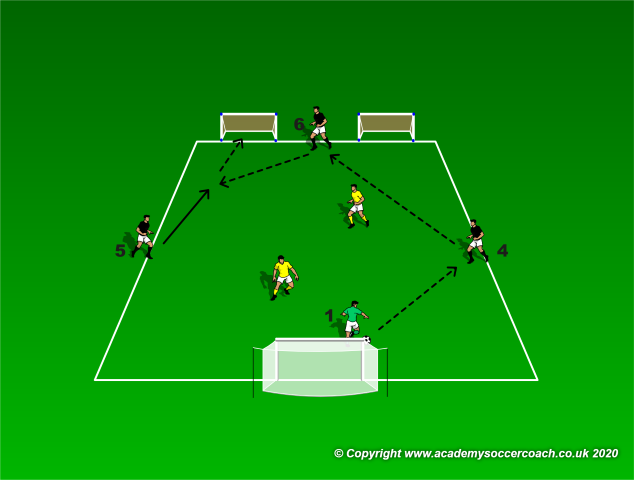
GK Distribution Under Pressure
By Philip Cauchi –
Title: Playing the ball with the feet under pressure
Aim: To be able to play accurate vertical passes when under pressure.
Key points:
1. Be light on the balls of the feet.
2. Oriented first touch.
3. Weight and direction of the kick (pass).
Practice: Receive the ball to score in the mini goals.
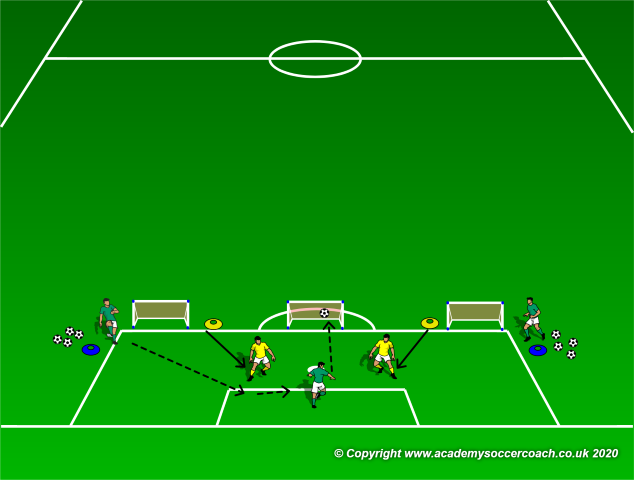
Preparation: A server – that can be the goalkeeper coach, a player recovering from an injury, or another goalkeeper – is positioned at each top corner of the penalty area with a supply of balls. Two other players act as opponents and start from the top of the penalty area as indicated in the above diagram.
Description: The servers take turns in passing the ball back to the goalkeeper who must quickly control the ball and kick it into any of the three mini goals. When a ball is passed to the goalkeeper by the servers the two defenders immediately apply pressure and aim to dispossess the goalkeeper and score in the regular goal.
Variations:
1. The servers may move to provide support in case the goalkeeper finds it very hard to kick the ball into any of the mini goals.
2. The servers play with the goalkeeper in securing possession of the balls until the moment to play forward into one of the mini goals is on. The area may need to be reduced in width for this variation (diagram below).
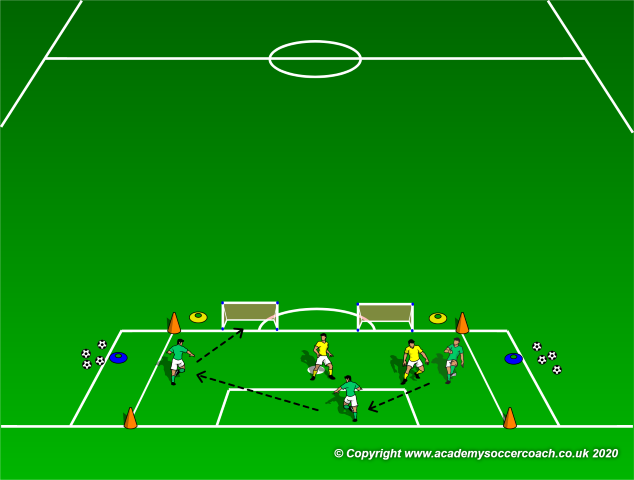
Progressions:
1. Reduce the area of practice so that the goalkeeper has less space and time to think.
2. Play the below small-sided situation where the goalkeeper together with his teammates have to play the ball forward into one of the mini goals simulating playing forward into midfield.

By Philip Cauchi
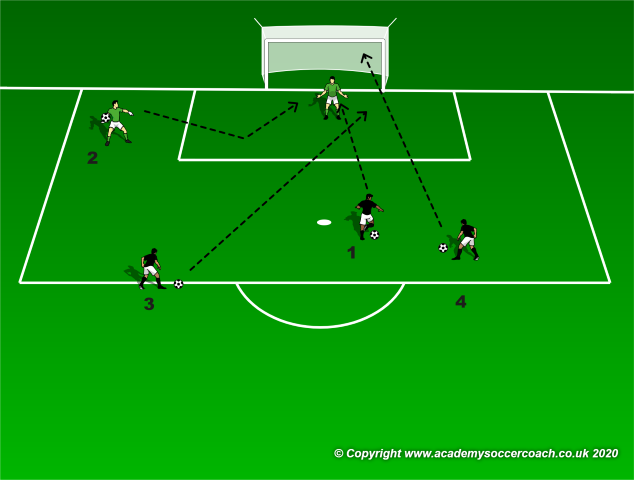
Saving Low Driven Shots Drills
By Philip Cauchi –
Title: Saving low driven shots drills
Aim: Save low driven shots aimed towards the corner of the goal.
Outcomes:
1. Start in the ready position with the hips slightly inclined forward.
2. Take a step forward before diving to make the save.
3. Lead into the dive with the toes of the foot on the side of the dive pointed diagonally towards the outside.
4. End up with the feet behind the line of the ball after making the save.
5. When on the ground rotate the legs inwards to use momentum to get up quickly into position after making the save.
Practice 1: The diving technique.
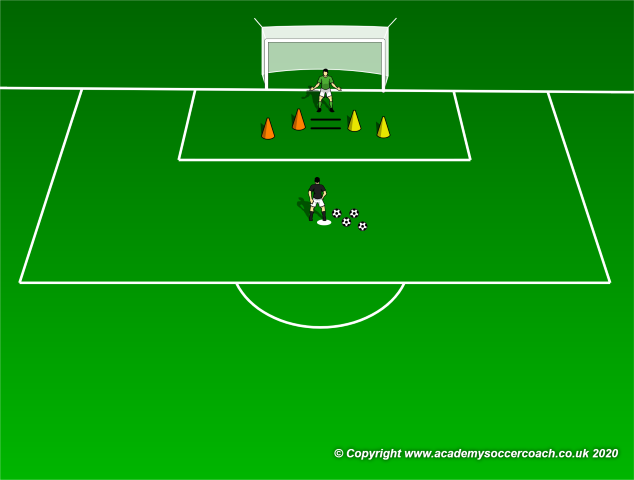
Preparation: The goalkeeper stands approximately two feet in front of the goal line in the ready position. A gate measuring a meter and a half in length is positioned to each side of the goalkeeper while two flat rubber lines are place in front of the goalkeeper and set approximately forty cm apart. The goalkeeper coach stands at a distance of eight yards in front of the goalkeeper.
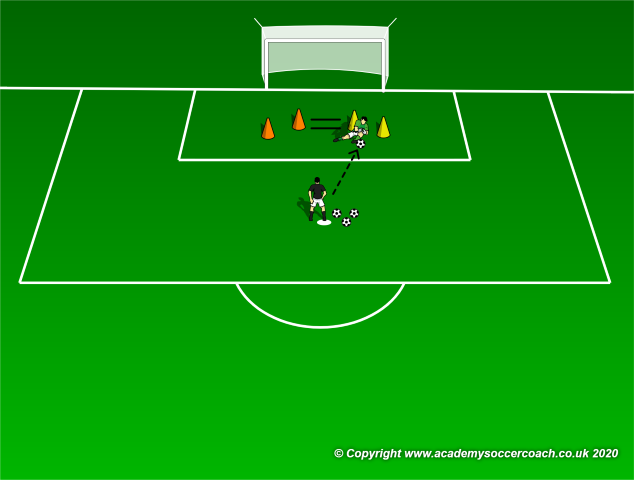
Description: The goalkeeper makes two quick forward steps prior to saving the low driven shot from the goalkeeper coach which is aimed to pass through the gates.
Variations:
1. Instead of making two quick forward steps the goalkeeper can make one or two forward jumps before diving to make the save.
2. The goalkeeper may or may not know to which gate (direction) the shot will be aimed.
3. Two shots are to be played in succession. After saving a shot, the goalkeeper has to get up quickly and make the next save. The goalkeeper may or may not know to which gate the two shots will be aimed.
Practice 2: FC Bayern München four shot practice.

This practice is taken from a Bayern Munich goalkeeping practice of which link is the following; https://www.youtube.com/watch?v=EqDGl0QEaO8.
Description:
1. Hi shot aimed at the goalkeeper from a close range that the goalkeeper has to securely catch.
2. Ball bounced once on the ground and the goalkeeper makes the save.
3. Low driven shot across the goal aimed at the left bottom corner of the goal (from the goalkeeper’s perspective).
4. Random shot at goal.
Practice 3: 3v1 to shoot.
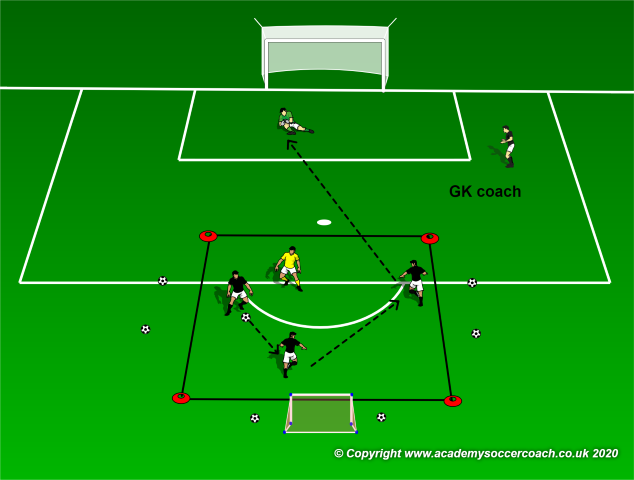
Preparation: An area measuring 10 yards by 10 yards is marked between twelve and sixteen yards from the goal. A goalkeeper is in goal while a defender and three attackers are placed inside this area.
Description: The three attackers aim to keep possession and after making three consecutive passes they can shoot on goal. The shots must be low driven (on the ground). The defender aims to win the ball and score in the mini goal positioned outside of the area. If the shot doesn’t take place after at least twenty seconds, the coach calls out “Shoot!” and the attacker with the ball takes a low driven shot at the goal defended by the goalkeeper.
Progression: After shooting at goal from the 3v1 situation, another ball is played to an attacker by the coach who has to finish with a first timer on goal.
By Philip Cauchi
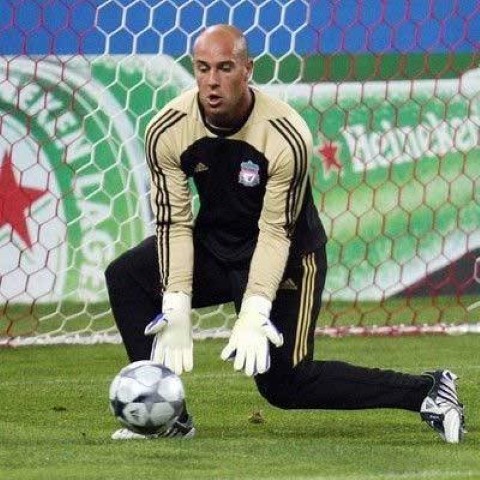
Saving Low Driven Shots
By Philip Cauchi –
Title: Saving low driven shots.
Aim: Use the scoop technique to save shots close to the body.
Outcomes:
1. Feet shoulder-width apart.
2. Stay behind the ball’s trajectory.
3. Eyes fixed on the ball.
4. Be light with the weight on the balls of the feet.
5. Arms and hands close with the palms together and opened towards the ball to scoop it up.
6. Rotate the body towards the ball.
7. Scoop the ball up without dropping the knee.
8. Clutch the ball to the chest and lean forward to secure it.

The scoop technique is used to save shots that are close to the body.
Practice 1: Catching low driven shots on different sides of the body.
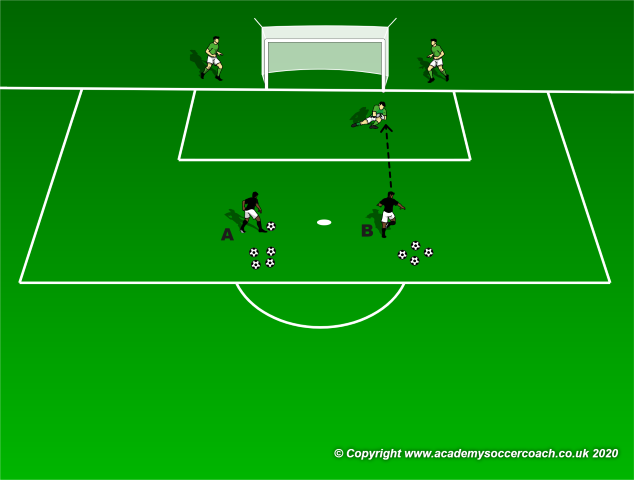
Preparation: Two servers A and B (who could be the goalkeeper coach, assistant coaches, and other goalkeepers waiting for their turn and even injured players) positioned in line with each corner of the goal and approximately ten yards away. Each server has a supply of balls.
Description: The two servers kick low driven shots for the goalkeeper to save. The shots must be aimed close to the goalkeeper. After making a save, the goalkeeper quickly gets up into the ready stance to make the next save from the other server. The goalkeeper makes six consecutive saves, alternating between the two servers and then rests for one and a half minutes to two minutes before taking on the next set of shots.
Progressions:
1. The servers get closer to each other and they figure out the order of the shots. Therefore, the goalkeeper will never know from whom the shot will arrive.
2. As in progression one but the waiting goalkeepers are positioned in front of the goalkeeper in goal to distract his/her vision.
Practice 2: Goalkeeper battle on two mini goals.
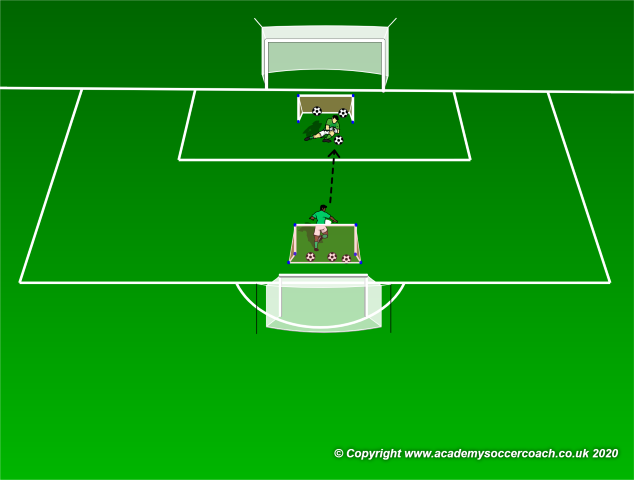
Preparation: Two mini goals are positioned ten yards apart and facing each other in front of regular goalposts so that the goalkeepers are orientated as they would normally be in a regular match. A number of balls are positioned in each mini goal.
Description: The goalkeepers kick the ball in an attempt to score in the opponent’s goal. They compete who of them can score the most goals in the mini goals in a pre-set amount of time.
Progression: The goalkeepers protect two mini goals positioned close to each other while trying to score on the opposite goal.
Practice 3: 2v2 + 1 + 2 target goalkeepers.
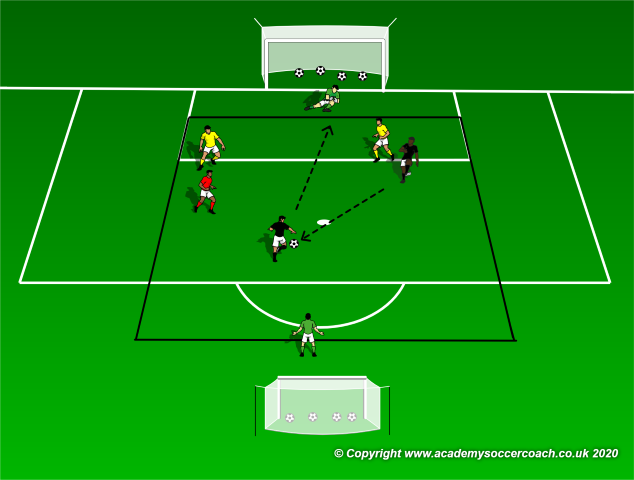
Preparation: Mark an area measuring 20 yards by 15 yards. Two teams each composed of a goalkeeper and two players plus a neutral player who plays for the team in possession take part. Teams have their goalkeeper positioned at their assigned end line.
Description: Both teams aim to score by passing the ball hard on the ground to the goalkeeper on the opposite line who must catch and protect it using the scoop technique. The goalkeepers also help their team to keep possession of the ball by passing it.
Progression: Make the area narrower (approximately 10 yards) and play a normal game (with shots on goal) where both teams are assigned to protect a goal and attack the opposite.
By Philip Cauchi

Closing Down the Shooting Angle
By Philip Cauchi –
Aim: Narrow down the opponent’s shooting angle.
Outcomes:
1. Feet shoulder width apart.
2. Toes pointed forwards.
3. Knees slightly bent.
4. Be light on the balls of feet.
5. Eyes focused on the ball.
6. Lean slightly forward.
Practice 1: Catching mid-level balls from three different shooting angles.
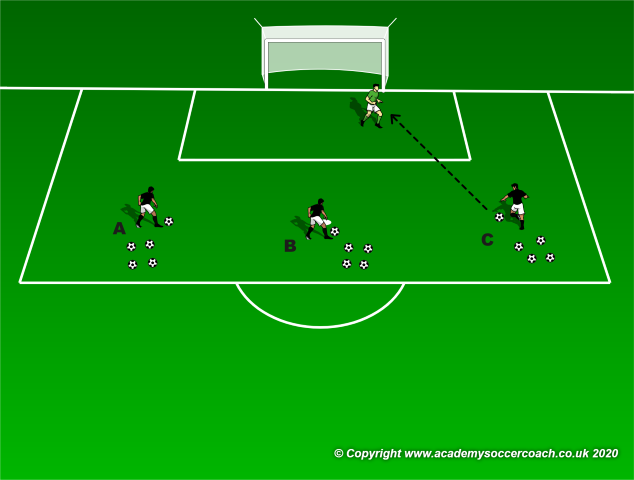
Preparation: Goalkeeper in goal and three other goalkeepers/servers (who can be coaches) positioned in the middle, to the left and to the right of the goal, ten meters away from the goal line. Each of the servers is supplied with a number of balls.
Description: The servers take their turns to kick mid-level balls straight at the goalkeeper who should quickly move to cover the angle.
Progressions:
1. The coach calls out which of the three serves kicks the ball.
2. The balls may be aimed at different heights and angles.
Practice 2: Quick get-ups to save mid-level shots.
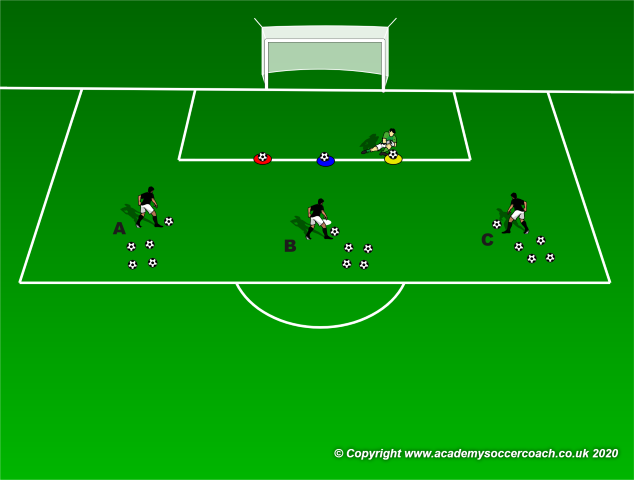
Preparation: As for practice 1 but now three markers each of a different color are positioned on the edge of the goal area. One of them in line with the middle of the goal, the other in line with the right corner of the goal, while the other is in line with the left corner of the goal. A ball is placed at each of these markers.
Description: The coach calls out a color which corresponds to the marker at which the goalkeeper dives to catch the ball as if making a save. The goalkeeper gets up on his feet to save the mid-level shot from the server that the coach calls.
Variation: Instead of calling out the color of the markers, the coach raises a marker that corresponds to the marker at which the goalkeeper dives to catch the ball.
Practice 3: GK+2 v GK+2 + 1 neutral on two regular goals.
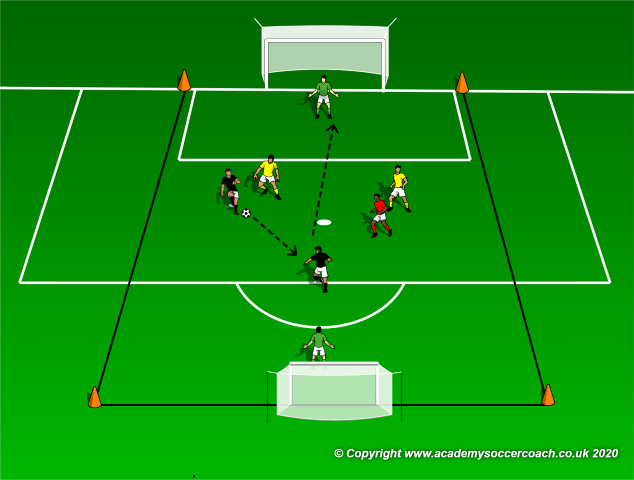
Preparation: Mark an area measuring 20 yards by 15 yards. At each end line a regular goalpost is positioned. Two teams made of a goalkeeper and two outfield players compete with the aid of a neutral player who plays for the team in possession.
Description: Play always starts from the goalkeeper of the team in possession whenever the ball goes out of play or a goal is scored. It is important to play in short repetitions as this is a very intensive practice for the goalkeepers who must be continuously alert to make saves as well as play the ball with their feet. The goalkeepers are not allowed to score.
Progression: Play with two neutral players who are positioned at each side line. This should overload the goalkeeper more in terms of shots on goals.
By Philip Cauchi
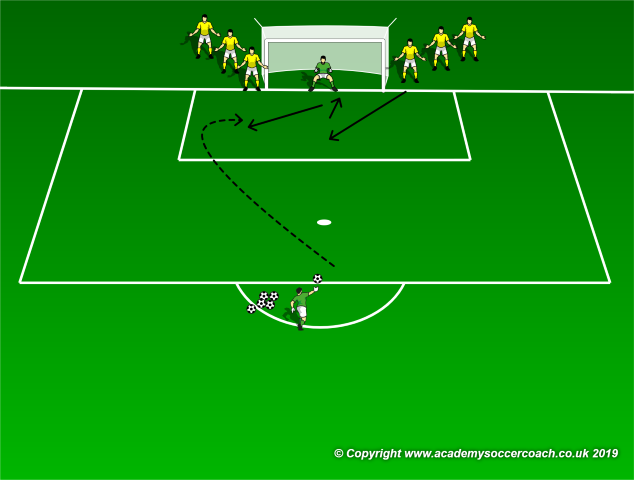
How to Call For the Ball
By Mike Smith –
In almost every game, there are going to be those moments where the keeper and the defenders both have a play on the ball. While we all know the keeper can and should call off the defense, most of the time coaches just go with any outcome which doesn’t result in a goal as the appropriate play. We may just yell “Call it” to the keeper or “ Listen to your keeper” to the defense and hope for better next time. However, from a developmental standpoint ,i.e. practice, the keeper should call anything they are making a play on and the defenders should “back off” and allow the keeper to make the play, regardless if the keeper actually makes the play or not.
The idea here is certainty. Certainty is a strength and will create definite, predictable outcomes. Uncertainty creates confusion and unpredictable outcomes. So while we will all take anything which doesn’t allow a goal in a game, the best course of action in practice is to steer your keeper and defensive unit towards the certain outcome – if the keeper calls it, the keeper gets it.
Set Up
This drill is best done with at least 2 keepers, if your squad only has one dedicated keeper, insert your back up keeper for this activity. In the face of goal, ( shown below ) two keepers wait for a service from the top of the 18. When the ball is served, the first keeper to call it ( by yelling KEEP! or KEEPER! ) makes the save. Another ball is served immediately – presumably for the second keeper to call and save. IF, the keeper who saves the first ball can make the save and call the second ball as well, they will get a chance at two saves. Play is reset after every two services. The keepers cannot call for the second save until after the first service is saved. The server ( preferably an additional keeper or coach ) should make sure at the start of the drill the second service is hit before the first one can be saved. This gives the keepers equal time to warm up and get the feel of the drill. As the drill progresses, the server can take some time between the first and second service and create some friendly competition between the two keepers. Balls should be served in a variety of ways – from the ground to a lob with the only condition being all balls are served on frame.
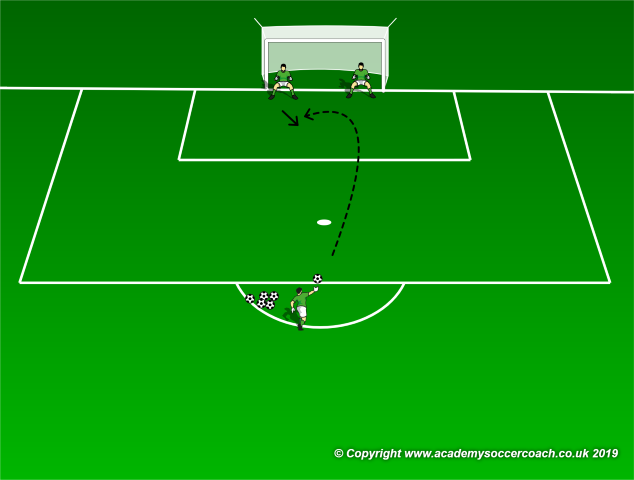
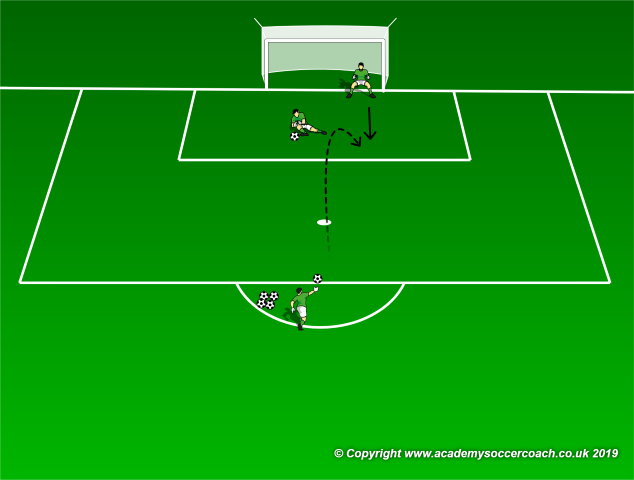
Coaching Point
It is important the keeper actually yell KEEP or KEEPER as opposed to MINE or I GOT IT. Ideally all players are letting each other know when they are making a play on a contested ball and MINE or I GOT IT does not definitely mean KEEPER, especially in the heat of the moment. Again, be certain – make sure the keeper is saying KEEP.
Progression 1
Once the keepers have gotten the hang of calling for the ball, bring in 4 to 6 defenders. Start them one at a time running in from the post. The services now may be anywhere inside the box. One defender at a time comes out for each service. If the keeper calls for it, the defender retreats back towards the goal mouth – ( where the next play will be if the keeper misses the ball ) . If the keeper does not call for it, the defender settles and passes it back to the server. Progress this to where two defenders ( one from each post ) come out each time.

Progression 2
Now add 4 to 6 attackers as well, coming in groups of two. The action here should be continuous after the first ball is served. To start, the keeper sends a ball out to the attackers who are waiting 30 to 40 yds out. When the attacker settles the ball, 4 defenders come out, two off each post. The attacking group has 3 seconds to serve / shoot the ball in – thus the receiving attacker will most likely serve it and the second attacker will crash in to attempt a finish. There is a supply of balls waiting with the other attackers. IF the defense or keeper wins the ball clean, they send it immediately out to the next two attackers. If a shot is missed or the ball is cleared out, the next two attackers take a ball and attack, following the 3 second guideline. Here is the trick – the defenders MUST get back to the post before coming back in and MUST interchange 2 players each time. This will create a lot of movement and chaos in front of the goal, all while a ball is being served in, and is the perfect condition for the keeper to practice creating CERTAINTY by calling the ball and having the defenders step back and cover goal.
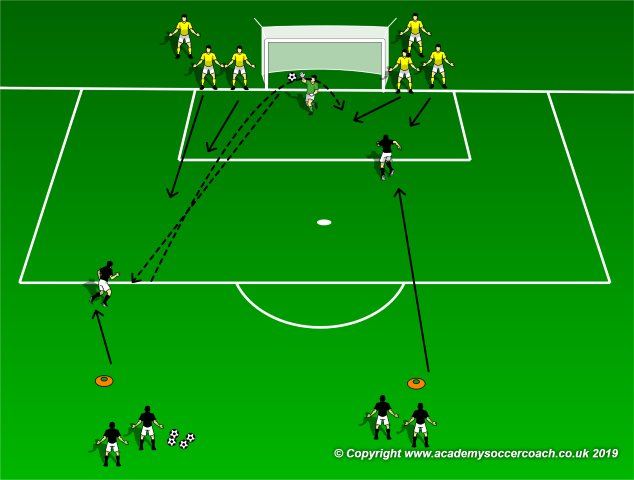
Coaching Points
Progression 2 can be adjusted to create the desired effect – which is balls coming in with several defenders and the keeper attempting to come in quickly and play it. The coach should focus entirely on the communication and corresponding movement between the keepers and the defenders. IF the keeper calls is, defenders step back and cover, keeper makes the play. IF the keeper holds their position in the net, defenders make the play.
By Mike Smith
Currently the Head Coach for University Heights Academy Boys Soccer in Hopkinsville, KY , Mike is in his 14th year as a high school head coach with 23 years coaching experience overall and 34 year as a student and fan of the game. He holds a USSF D License.
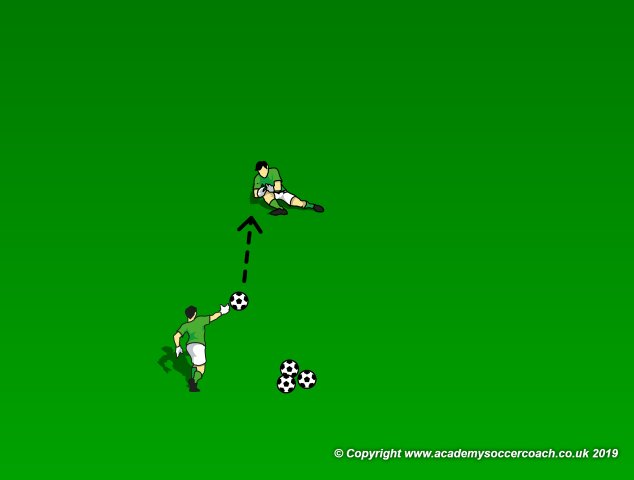
Teaching Diving to the Ground
By Mike Smith –
“JUST FALL ON IT!!!!” I have carved out my coaching niche over the past 20+ years working with not just youth soccer – (U8 – High School) but also new or struggling teams and programs. One constant for me has been the need to “make” a keeper for almost every team I have ever coached. This high school season, I actually took over a struggling program whose only bright spot was a very talented sophomore keeper – who then tore his ACL playing baseball during the offseason and was not able to play soccer this year. Maybe it is me? Joking aside, ( and my keeper is recovering well and set to go next season ) I was once again tasked with making a keeper and fortunately found a talented athletic freshman who ended the season in the top 25 in the state for saves. He would have made more saves, especially earlier in the season, if he had of taken my initial advice – “ JUST FALL ON IT”.
For some keepers / keeper candidates, going to ground is easy ( and us coaches then coach them on not going to ground too quickly ) but for many – getting comfortable diving and smothering the ball takes some time, patience AND instruction. The main instruction points are footwork related and this lack of footwork shows up in games when keepers either don’t go all the way to the ground and cover the ball – which leads to easy saves slipping right through their hands ( or legs ) OR keepers making the dive but ending up facing the posts because they turned their bodies away from the ball and then dove. These are issues which can be “ drilled out” or good habits that can be “ drilled in “ during practice.
Set Up
For me, if a keeper isn’t comfortable on the ground, I get them comfortable by putting them on the ground. Start with two keepers / keeper candidates working together or with one keeper at a time and a coach serving the balls. The keepers are laying on their sides on the ground, one at a time saving, one at a time serving. The idea is for them to work on extending their ground ( bottom ) hand out along the ground, in line with the goal line, and having the top hand free for cover. This idea of bottom hand to ball, top hand for cover is important as the bottom hand’s shoulder ( range of motion ) is limited by the ground where the top hand’s shoulder is free – thus the top had has a greater range of motion.
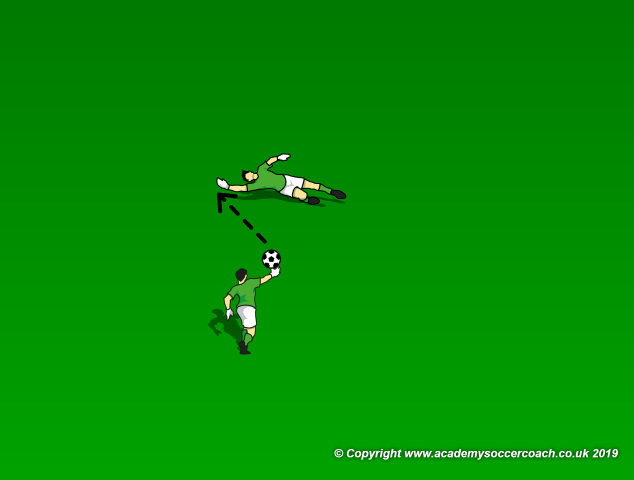
Once they have worked on the ground on both sides, they start on their bottoms, with their legs extended towards each other and repeat a similar progression – balls served on alternating sides low near the ground.
The next step is the critical point – working on the knees. This is where either the discomfort from being on their knees, or the realization being in a deep squat and going to ground isn’t much different from being on your knees and going to ground ( and is in fact more comfortable ) will flip the switch. Again, ( see below ) balls are served on alternating sides low near the ground.
2
Progression
Bring in the shooters and see if the ground training has helped. Set up designated areas for the shots to go ( as shown below – target area is between the cones and posts) and let the keepers make saves.

Coaching Points
The coach should focus entirely on the positioning, foot work and hand work of the keepers here. Are they shifting their weight and getting low first before the dive? Is their bottom hand extending and reaching first? ( I like to use this hand work as the idea of their bottom hand extending and “ leading them to ground” ) When they land are they extended across goal facing the field or facing the post? These are all critical factors in getting your keeper to JUST FALL ON IT.
By Mike Smith
Currently the Head Coach for University Heights Academy Boys Soccer in Hopkinsville, KY , Mike is in his 14th year as a high school head coach with 23 years coaching experience overall and 34 year as a student and fan of the game. He holds a USSF D License.
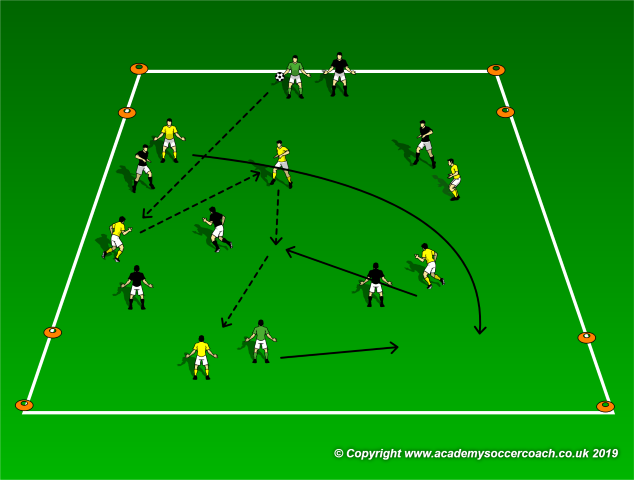
Team Handball For Goalkeeper Training
By Mike Smith –
When I was getting my USSF D License I remember the instructor saying “If you are working on defense, work on defense. Don’t worry about what the attackers are doing!” What the instructor (Coach Parrish ) was trying to do was make sure the coaches understood the need for clarity and purpose in training, basically staying on task. This is simple when the drill is simple, however there are tons of times when drills can be dual, triple and even quadruple purpose especially when they are game / scrimmage related. This is one of those drills. In an effort to make Coach Parrish happy however, I will ask those using it to focus only on the keeper work aspects of the activity.
We have all asked our keepers to “command the box” . I have found a great way to demonstrate / practice this is through team handball. (the other purposes are overall team work, movement off the ball and team communication ) Below is a demonstration of the game and the setup, along with some keeper specific aspects which can be used as a progression.
Set Up
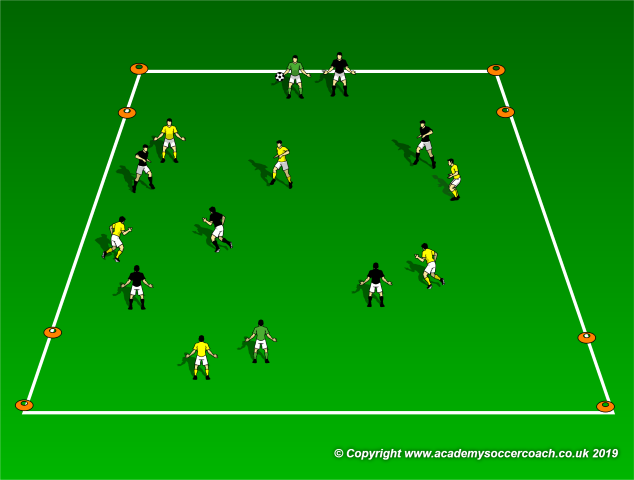
Set up a field approximately 20 yds wide and 40 yds long. The final 10 yd sections on each end are “end zones”. The keepers are the designated defensive players in each end zone. Play starts with the keeper serving a ball into a team mate who, don’t be shocked soccer purists, catches it in their hands. Once a catch is made, the player with the ball must stop moving, and has to pass to a team mate, who also must stop when the catch is made and pass. The ball cannot be slapped or taken out of the ball carriers hand and defenders must stay an arms length away to give room for the ball carrier to pass. The ball carrier has 5 seconds to pass or it is a turnover. Also, any balls which are not caught and hit the ground are turnovers, so the defending group does not have to intercept passes cleanly, just knock them down to the ground. All turnovers are left where the ball was given up or hit the ground. Goals are scored initially by sending a pass into the target player, who is defended by the goalie. Initially no other players are allowed inside the end zones but can switch out target players after a goal is scored.

The idea is for the keepers to read the field, and play the BALL when it is served in, not get caught up in the movement of the other players. After all, in a game, when the service is coming in, the keeper’s job is the ball. The diagram above shows how initially the keeper could get drawn away following an open player.
Progression
Once the keepers have the hang of it, release the target players to play the entire field and allow other field players to come into the end zones, but restrain the keepers to the end zones. In this progression, the keepers should not really have a mark and should be free to play the ball as in a real match.
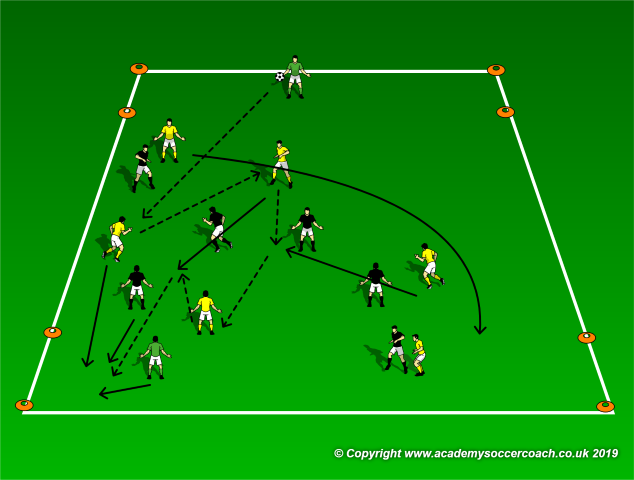
Coaching Points
The free play with the keepers restrained to the end zones should be the bulk of the exercise. Here the coach should make sure the keepers are reading the field, playing the ball, calling “KEEP” when going for the ball and making a good distribution afterwards. As a final progression, release the keepers from the end zones and let them play the entire field.
By Mike Smith
Currently the Head Coach for University Heights Academy Boys Soccer in Hopkinsville, KY , Mike is in his 14th year as a high school head coach with 23 years coaching experience overall and 34 year as a student and fan of the game. He holds a USSF D License.

Stopping A Near Post Cross
By Mike Smith –
Over the course of my coaching career I have struggled with a contradiction in my coaching style. Offensively, I swear by just getting the ball down the field and making a team eat crosses. This is my shotgun approach, just keep the ball going across the opponents net and good things will happen,( hopefully the middle will soften up when they step out to stop us from crossing). However, defensively, I find myself thinking – “ if I can just keep a team out wide and make them serve long crosses, and prevent shots from inside my box, we’re gonna win a lot of games.” The best offensive tactic cannot be the best defensive tactic can it?
One of the things I make sure of when employing my contradictory style is having a keeper who can stop the ball from actually getting across. I have found when making a team play crosses actually plays into the way your keeper practices stopping offense every day, it can be a winning combination.
Set Up
As a warm up, have a line of servers, one on each post of the goal for teams with two keepers, roll in balls to the keeper. This is a standard warm up activity for a lot of teams, where the servers roll balls in central, left and right progressing up from the ground, knee, waist, shoulder and above the head areas.
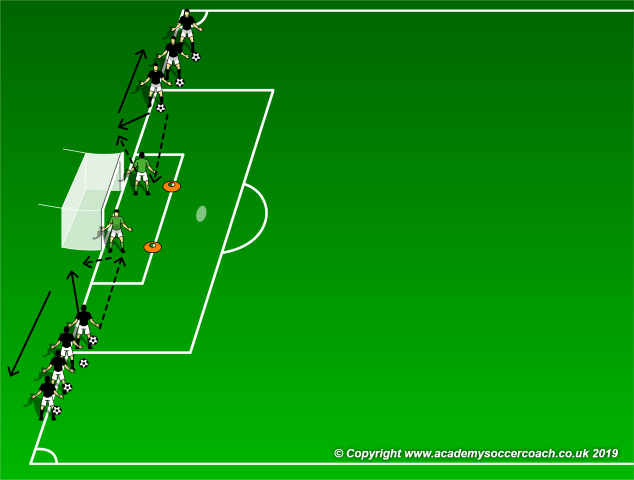
After this, have the keepers roll a ball out to the server, who must attempt to cross it through a cone gate, where the keeper must make the save with their hands. ( a finisher can be located on the back side for crosses that get through as a progression.)
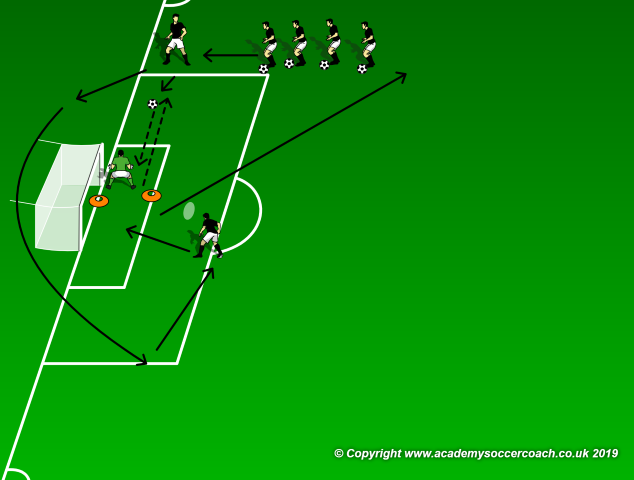
Final Progression / Coaching Points
Finally, set up a 3 attackers vs 4 defenders inside the box drill, with a 4th attacker free to hit a cross. Be sure to alternate crossing sides. The idea here is for the keeper to attempt to aggressively win crosses, so the coach should focus on good keeper positioning, communication and aggressively attacking the ball. As shown below, groups of 3 attackers play the ball from just outside the top of the 18 to the waiting service attacker. 4 defenders wait at the top of the 6 to pick up marks and defend the cross. While the serving attacker can serve from anywhere inside of 18 yards and all serves should go far post, the coach should make sure several services are made from deep and driven into the near post. After the service is made, the server may join the attack. Once the groups, and keeper, have gotten into a flow, make it a 4 v 4 activity inside the box, with the only requirement being all goals must be scored off a cross.
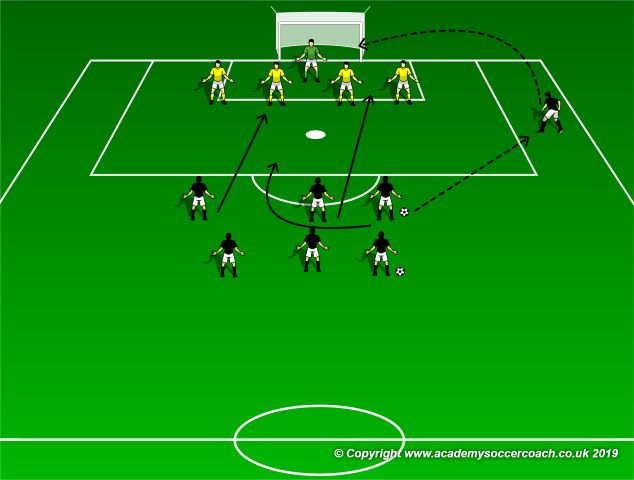
By Mike Smith
Currently the Head Coach for University Heights Academy Boys Soccer in Hopkinsville, KY , Mike is in his 14th year as a high school head coach with 23 years coaching experience overall and 34 year as a student and fan of the game. He holds a USSF D License.
